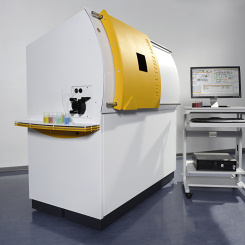With the SPECTRO MS at Pittcon 2010 SPECTRO presents the first fully simultaneous measuring mass spectrometer with inductively coupled plasma in the world. The instrument received the PittCon 2010 Editor's Silver Award.
Background: ICP-MSFor almost 30 years, mass spectrometry with inductively coupled plasma (ICP-MS) has belonged to the established procedures for elemental analysis: The element contents are analyzed based on the different masses of the elements. The liquid sample is sprayed with a nebulizer into an ionized, 10,000 degree Celsius argon plasma. The plasma ionizes all of the elements contained in the sample. The ions are transferred into the ion optic by a vacuum interface, bundled into a beam and focused into the actual mass spectrometer. The mass spectrometer separates the ion beam according to the mass/charge ratio. The detector records the ions, enabling an analysis of the elemental contents.
A New Era in ICP Mass Spectrometry:

The unique combination of ion optic, mass spectrometer and detector makes it possible for the new SPECTRO MS – as the first ICP-MS instrument in the world – to separate and simultaneously detect the entire ion beam. The SPECTRO MS records the entire elemental spectrum between lithium and uranium for every analysis. Users achieve a greatly increased sample throughput rate and much better precision and accuracy compared to using a sequential mass spectrometer.
“The SPECTRO MS will change mass spectrometry forever. The option of being able to measure simultaneously will create a revolution on the market similar to the one created by the optical emission spectrometers several years ago,” reports Manfred Bergsch, SPECTRO’s Managing Director. “The SPECTRO MS delivers not only much more precise and reproducible results than a conventional mass spectrometer, but also measures a great deal faster; opening new perspectives and applications for laboratories.”
Simultaneous recording of the entire spectrum is enabled by a series of newly designed high-end components:
- A novel ion optic that is extremely efficient in transporting ions from the plasma into the mass spectrometer itself – while reliably removing neutral particles and photons from the beam.
- A double focusing sector field mass spectrometer with a Mattauch-Herzog design. An electrostatic analyzer and a permanent magnet are utilized to direct the ions onto a focal plane – without additional scanning of the ion beam.
- An extremely powerful Direct Charge Detector with 4,800 channels is placed in the focal plane of the mass spectrometer recording simultaneously the entire mass spectrum from lithium to uranium with an average of 20 channels per isotope. Each of these channels is additionally divided into two separate detectors with different signal amplification. This enables the SPECTRO MS to achieve a dynamic working range that allows even extreme isotope ratios to be precisely determined.
- With the innovative sleep-mode, the robust and user-friendly vacuum system features very low energy consumption.
The housing, software and excitation technology for the SPECTRO MS are closely related to those of the ICP-OES flagship, the SPECTRO ARCOS. A robust, free-running 27.12 MHz generator is used as the plasma generator in the new instrument; guaranteeing extremely stable power coupling in the plasma.
New Standards in the Research Laboratory
The range of applications for the new SPECTRO MS is diverse. Bergsch: “We see many application areas especially for public and commercial research and development laboratories. The number of samples and the requirements for these institutions are extremely high. The SPECTRO MS can truly demonstrate its strengths here – precision, reproducibility, detection limits, sample throughput. We will quickly establish the SPECTRO MS as the standard system in this area.”
Revealing Isotope Ratios
In addition to research laboratories, simultaneous mass spectrometry is attractive for many branches of industry: Environmental, chemical and pharmaceutical laboratories profit greatly from the instrument’s detection limits and sample throughput rates. Precious metal processors and refineries will appreciate the high precision of the instrument. New applications can be developed with the option to examine isotope ratios together with the ability to transfer the precision of the isotope ratio analysis to the quantitative determination of element contents using isotope dilution: In this way, geology laboratories can more accurately characterize samples.
Source: Adapted from Spectro
 Related EVISA resources:
Related EVISA resources:
 Brief summary: ICP-MS: A versatile detection system for speciation analysis
Brief summary: ICP-MS: A versatile detection system for speciation analysis
 Company database: Spectro and its products
Company database: Spectro and its products
 Instrument database: Commercial available ICP-MS instruments
Instrument database: Commercial available ICP-MS instruments
 Instrument database: Historical ICP-MS instruments
Instrument database: Historical ICP-MS instruments
 Instrument database: Spectro MS
Instrument database: Spectro MS
 Related Information
Related Information
 Youtube: Spectro MS - Flexibility, Productivity, Precision and Accuracy
Youtube: Spectro MS - Flexibility, Productivity, Precision and Accuracy
 Related EVISA News
Related EVISA News
 March 16, 2018: Thermo Fisher Launches New ICP-MS in Semiconductor Manufacturing
March 16, 2018: Thermo Fisher Launches New ICP-MS in Semiconductor Manufacturing
 New Triple Quadrupole ICP-MS launched by Thermo Fisher (14.03.2017)
New Triple Quadrupole ICP-MS launched by Thermo Fisher (14.03.2017)
 June 9, 2016: Agilent is introducing the second generation of Triple Quadrupole ICP-MS
June 9, 2016: Agilent is introducing the second generation of Triple Quadrupole ICP-MS
system: The 8900
 July 17, 2013: Agilent Technologies Triple Quadrupole ICP-MS Selected for R&D 100 Award
July 17, 2013: Agilent Technologies Triple Quadrupole ICP-MS Selected for R&D 100 Award
 July 19, 2012: Triple Quad ICP-MS: Pushing the limits for quantitation of phosphorus and sulfur
July 19, 2012: Triple Quad ICP-MS: Pushing the limits for quantitation of phosphorus and sulfur
last time modified: March 15, 2025